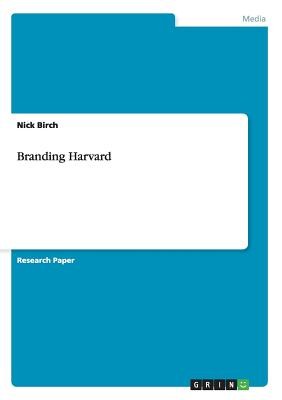
- We will send in 10–14 business days.
- Author: Nick Birch
- Publisher: GRIN Verlag
- Year: 2014
- Pages: 40
- ISBN-10: 3656674531
- ISBN-13: 9783656674535
- Format: 14.8 x 21 x 0.3 cm, softcover
- Language: English
- SAVE -10% with code: EXTRA
Reviews
Description
Research Paper (postgraduate) from the year 2014 in the subject Design (Industry, Graphics, Fashion), grade: 1.15, Central Queensland University, course: Brand Image Design, language: English, abstract: There are nearly 4,000 colleges and universities in the United States and almost all of these institutions have continued to attract enough students to remain operational year after year, according to Author and Marketing guru Roger Dooley (2013). That's about to change, and one of the key differences in who survives won't be the academic output of the faculty or the amenities available to students. It will be a factor seemingly unrelated to the schools' mission: branding. (Dooley, 2013) Nurko (2010) says that 'branding is a vital tool for Universities to consider as they not only seek to attract the brightest students, but they also seek to attract and retain top academic faculty talent, become centres for research grants as well as attract investment funding and endowments to subsidize future growth'. The days when Universities were simply hallowed halls of academia around the world are gone. Today, Universities are not only academic institutes but they are commercial organisations and engines of economic growth for their communities and shareholders. Universities compete for talent at both the student level, but also for faculty personnel and investment funding. Both private and public Universities are more accountable for their balance sheets, as well as for their level of academic rigour and reputation. In a world in which academia, commerce and government overlap, the role higher education plays has never been more critical - yet, at the same time more controversial. For this reason, Universities are deploying marketing and branding strategies and tactical executions which seek to help them differentiate while also compete for potential student attention, financial investment and ultimately reputation accolades. (Nurko, 2010) The current Harvard coat of arms
EXTRA 10 % discount with code: EXTRA
The promotion ends in 18d.09:17:03
The discount code is valid when purchasing from 10 €. Discounts do not stack.
- Author: Nick Birch
- Publisher: GRIN Verlag
- Year: 2014
- Pages: 40
- ISBN-10: 3656674531
- ISBN-13: 9783656674535
- Format: 14.8 x 21 x 0.3 cm, softcover
- Language: English English
Research Paper (postgraduate) from the year 2014 in the subject Design (Industry, Graphics, Fashion), grade: 1.15, Central Queensland University, course: Brand Image Design, language: English, abstract: There are nearly 4,000 colleges and universities in the United States and almost all of these institutions have continued to attract enough students to remain operational year after year, according to Author and Marketing guru Roger Dooley (2013). That's about to change, and one of the key differences in who survives won't be the academic output of the faculty or the amenities available to students. It will be a factor seemingly unrelated to the schools' mission: branding. (Dooley, 2013) Nurko (2010) says that 'branding is a vital tool for Universities to consider as they not only seek to attract the brightest students, but they also seek to attract and retain top academic faculty talent, become centres for research grants as well as attract investment funding and endowments to subsidize future growth'. The days when Universities were simply hallowed halls of academia around the world are gone. Today, Universities are not only academic institutes but they are commercial organisations and engines of economic growth for their communities and shareholders. Universities compete for talent at both the student level, but also for faculty personnel and investment funding. Both private and public Universities are more accountable for their balance sheets, as well as for their level of academic rigour and reputation. In a world in which academia, commerce and government overlap, the role higher education plays has never been more critical - yet, at the same time more controversial. For this reason, Universities are deploying marketing and branding strategies and tactical executions which seek to help them differentiate while also compete for potential student attention, financial investment and ultimately reputation accolades. (Nurko, 2010) The current Harvard coat of arms


Reviews